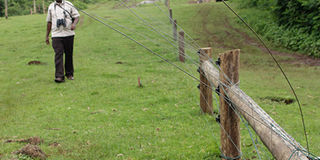Conservationists to use Sh1bn to fence off Mt Kenya Forest

Solar-powered fence along Mt Kenya Forest. At least Sh1 billion is needed to complete the fencing off of the Mt Kenya Forest. PHOTO | FILE | NATION MEDIA GROUP
What you need to know:
- Fencing off the Aberdare Forest was also supported by various corporates, including the Nation Media Group.
- Mr Lambrechts said Rhino Ark is also adopting new technologies to increase efficiency of the fence.
- They include automatic gates on elephant corridors, fence voltage monitoring systems and patrol monitoring systems.
At least Sh1 billion is needed to complete the fencing off of the Mt Kenya Forest as the Kenya Wildlife Service (KWS) and Rhino Ark seek to replicate the conservation gains made in the Aberdare Forest.
The fencing off of the forests has been hailed as a solution to the constant human-wildlife conflicts that have cost the government billions of shillings in compensation claims over the years.
Rhino Ark Executive Director Christian Lambrechts said fencing off the 450-kilometre Mt Kenya ecosystem will cost about Sh1.5 billion compared to Sh800 million that was spent on the 400km Aberdare Ranges.
COST PER KM
It costs about Sh2.5 million to build one kilometre of electric fence.
Fencing off the Aberdare Forest was also supported by various corporates, including the Nation Media Group.
So far, about 200 km of Mt Kenya Forest stretching from Kirinyaga to Meru County have been fenced off, significantly reducing cases of human-wildlife conflict.
Mr Lambrechts said Rhino Ark is also adopting new technologies, including automatic gates on elephant corridors, fence voltage monitoring systems and patrol monitoring systems to increase efficiency of the fence.
HARMONY ACHIEVED
“Since we completed the electric fence around Aberdares 10 years ago, we have been able to bring harmony between communities and wildlife. However, due to poachers and wild animals adopting new ways of beating the fence, we are introducing technologies that give real-time updates on the status of the fence,” he said.
“The fence monitoring system sends real time SMS messages if the voltage goes below the recommended 5 volts. Based on the duration of the outage, we can determine whether it is human interference or a natural damage and take appropriate action,” Mr Lambrechts explained.
He said the fence monitoring system has been fully rolled out on the 43-kilometre Mau Eburu Forest fence.
“From a smartphone, the fence manager can see the status of the entire fence from a digital map. The fence manager can also remotely switch it on or off when maintenance is ongoing,” he said.
MONITORING SYSTEM
The conservationists are also testing the patrol monitoring system which will enable KWS to have real-time access to rangers securing various ecosystems.
“The patrol teams will be equipped with rugged smartphones that will relay real-time data on location of rangers and send critical information and pictures on what is happening in the wild. This will enable us know how good we are in patrolling our ecosystems,” said the Rhino Ark boss.
Also being piloted are smart gates that use motion sensors to let in elephants into protected areas from other habitats.
“Once the sensor detects an elephant, it triggers the gate to open and sends an SMS to the fence manager. The fence manager also receives a live feed of images from the ground and is able to close the gate using an SMS command,” Mr Adam Mwangi, Rhino Ark fence manager in Mt Kenya and Aberdare, said.
According to Upper Tana Natural Resources Management Project which supported the construction of a 60 km fence along Mt Kenya, the electric fence reduced human-wildlife conflicts by 97 per cent annually.
ANIMAL POPULATIONS
Aberdare National Park Senior Warden Collins Omondi said since the fencing of the ecosystem was completed 10 years ago, cases of human-wildlife conflict have dropped despite the growth in elephant and buffalo populations.
“We have not recorded any human death for the last five years and poaching has declined. This has saved the government millions in money that could have gone to compensating crop damage, injuries and death. The fence has also contributed to increased agricultural production along the Aberdares leading to an improved economy among residents,” Mr Omondi said.
He said the fencing has also contributed to a growth in the population of the critically endangered mountain bongo antelope.
Rhino Ark, which raises most of the funds from Rhino Charge, an annual off-road car competition, is also putting up electric fences along Southwest Mau and Kakamega forests.
Ololua, Ngong, Chyulu hills and Maasai Mau forests are also lined up for fencing off.
According to the Tourism ministry, more than 400 people were killed by wild animals between 2014 and 2017, with 77 deaths recorded in 2018.





